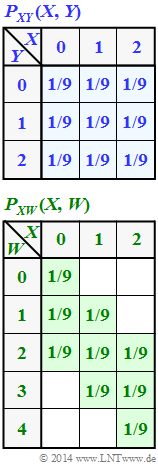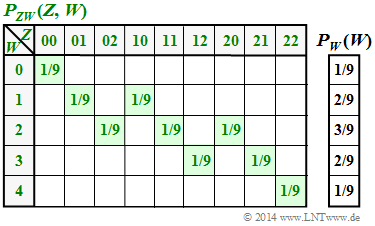Difference between revisions of "Aufgaben:Exercise 3.8: Once more Mutual Information"
| Line 59: | Line 59: | ||
===Solution=== | ===Solution=== | ||
{{ML-Kopf}} | {{ML-Kopf}} | ||
| − | '''(1)''' The<u>correct solutions are 1 and 2</u>: | + | '''(1)''' The <u>correct solutions are 1 and 2</u>: |
*With $X = \{0,\ 1,\ 2\}$, $Y = \{0,\ 1,\ 2\}$ , $X + Y = \{0,\ 1,\ 2,\ 3,\ 4\}$ holds. | *With $X = \{0,\ 1,\ 2\}$, $Y = \{0,\ 1,\ 2\}$ , $X + Y = \{0,\ 1,\ 2,\ 3,\ 4\}$ holds. | ||
*The probabilities also agree with the given probability function. | *The probabilities also agree with the given probability function. | ||
| − | *Checking the other two specifications shows that $W = X | + | *Checking the other two specifications shows that $W = X - Y + 2$ is also possible, but not $W = Y - X + 2$. |
| + | |||
| + | [[File:P_ID2769__Inf_A_3_7d.png|right|frame|To calculate the mutual information]] | ||
| − | '''(2)''' From the | + | '''(2)''' From the two-dimensional probability mass function $P_{ XW }(X, W)$ on the specification page, one obtains for |
*the joint entropy: | *the joint entropy: | ||
:$$H(XW) = {\rm log}_2 \hspace{0.1cm} (9) | :$$H(XW) = {\rm log}_2 \hspace{0.1cm} (9) | ||
| Line 73: | Line 75: | ||
* the probability function of the random variable $W$: | * the probability function of the random variable $W$: | ||
:$$P_W(W) = \big [\hspace{0.05cm}1/9\hspace{0.05cm}, \hspace{0.15cm} 2/9\hspace{0.05cm},\hspace{0.15cm} 3/9 \hspace{0.05cm}, \hspace{0.15cm} 2/9\hspace{0.05cm}, \hspace{0.15cm} 1/9\hspace{0.05cm} \big ]\hspace{0.05cm},$$ | :$$P_W(W) = \big [\hspace{0.05cm}1/9\hspace{0.05cm}, \hspace{0.15cm} 2/9\hspace{0.05cm},\hspace{0.15cm} 3/9 \hspace{0.05cm}, \hspace{0.15cm} 2/9\hspace{0.05cm}, \hspace{0.15cm} 1/9\hspace{0.05cm} \big ]\hspace{0.05cm},$$ | ||
| − | *the entropy of the random variable $W$: | + | *the entropy of the random variable $W$: |
:$$H(W) = 2 \cdot \frac{1}{9} \cdot {\rm log}_2 \hspace{0.1cm} \frac{9}{1} + 2 \cdot \frac{2}{9} \cdot {\rm log}_2 \hspace{0.1cm} \frac{9}{2} + | :$$H(W) = 2 \cdot \frac{1}{9} \cdot {\rm log}_2 \hspace{0.1cm} \frac{9}{1} + 2 \cdot \frac{2}{9} \cdot {\rm log}_2 \hspace{0.1cm} \frac{9}{2} + | ||
\frac{3}{9} \cdot {\rm log}_2 \hspace{0.1cm} \frac{9}{3} | \frac{3}{9} \cdot {\rm log}_2 \hspace{0.1cm} \frac{9}{3} | ||
{= 2.197\ {\rm (bit)}} \hspace{0.05cm}.$$ | {= 2.197\ {\rm (bit)}} \hspace{0.05cm}.$$ | ||
| − | Thus, with $H(X) = 1.585 \ \rm bit$ (was given), the result for the | + | Thus, with $H(X) = 1.585 \ \rm bit$ (was given), the result for the mutual information: |
:$$I(X;W) = H(X) + H(W) - H(XW) = 1.585 + 2.197- 3.170\hspace{0.15cm} \underline {= 0.612\ {\rm (bit)}} \hspace{0.05cm}.$$ | :$$I(X;W) = H(X) + H(W) - H(XW) = 1.585 + 2.197- 3.170\hspace{0.15cm} \underline {= 0.612\ {\rm (bit)}} \hspace{0.05cm}.$$ | ||
| − | |||
The left of the two diagrams illustrates the calculation of the mutual information $I(X; W)$ between the first component $X$ and the sum $W$. | The left of the two diagrams illustrates the calculation of the mutual information $I(X; W)$ between the first component $X$ and the sum $W$. | ||
| − | |||
| − | |||
| − | |||
| − | |||
| − | |||
| − | |||
| − | |||
| − | We attempt an interpretation of these numerical results: | + | [[File:P_ID2770__Inf_A_3_7c.png|right|frame|Joint probability between $Z$ and $W$]] |
| − | * The joint probability $P_{ ZW }(⋅)$ , like $P_{ XW }(⋅)$ , | + | '''(3)''' The second graph shows the joint probability $P_{ ZW }(⋅)$. |
| − | * If I know the tuple $Z = (X, Y)$ | + | *The scheme consists of $5 · 9 = 45$ fields in contrast to the plot of $P_{ XW }(⋅)$ on the data page with $3 · 9 = 27$ fields. |
| + | *However, of the $45$ fields, only nine are also assigned non-zero probabilities. The following applies to the joint entropy: $H(ZW) = 3.170\ {\rm (bit)} \hspace{0.05cm}.$ | ||
| + | *With the further entropies $H(Z) = 3.170\ {\rm (bit)}\hspace{0.05cm}$ and $H(W) = 2.197\ {\rm (bit)}\hspace{0.05cm}$ according to [[Aufgaben:Exercise_3.8Z:_Tuples_from_Ternary_Random_Variables| Exercise 3.8Z]] or the subquestion '''(2)''' of this exercise, one obtains for the mutual information: | ||
| + | :$$I(Z;W) = H(Z) + H(W) - H(ZW) \hspace{0.15cm} \underline {= 2.197\,{\rm (bit)}} \hspace{0.05cm}.$$ | ||
| + | <br clear=all> | ||
| + | '''(4)''' <u>All three statements</u> are true, as can also be seen from the right-hand side of the two upper diagrams. We attempt an interpretation of these numerical results: | ||
| + | * The joint probability $P_{ ZW }(⋅)$ is composed, like $P_{ XW }(⋅)$ , of nine equally probable elements unequal to 0. It is thus obvious that the joint entropies are also equal ⇒ $H(ZW) = H(XW) = 3.170 \ \rm (bit)$. | ||
| + | * If I know the tuple $Z = (X, Y)$, I naturally also know the sum $W = X + Y$. Thus $H(W|Z) = 0$. | ||
*In contrast, $H(Z|W) \ne 0$. Rather, $H(Z|W) = H(X|W) = 0.973 \ \rm (bit)$. | *In contrast, $H(Z|W) \ne 0$. Rather, $H(Z|W) = H(X|W) = 0.973 \ \rm (bit)$. | ||
*The random variable $W$ thus provides exactly the same information with regard to the tuple $Z$ as for the individual component $X$. This is the verbal interpretation of the statement $H(Z|W) = H(X|W)$. | *The random variable $W$ thus provides exactly the same information with regard to the tuple $Z$ as for the individual component $X$. This is the verbal interpretation of the statement $H(Z|W) = H(X|W)$. | ||
| − | *The joint information of $Z$ and $W$ ⇒ $I(Z; W)$ is greater than the joint information of $X$ and $W$ ⇒ $I(X; W)$, because $H(W|Z) =0$ | + | *The joint information of $Z$ and $W$ ⇒ $I(Z; W)$ is greater than the joint information of $X$ and $W$ ⇒ $I(X; W)$, because $H(W|Z) =0$, while $H(W|X)$ is non-zero, namely exactly as great as $H(X)$ : |
:$$I(Z;W) = H(W) - H(W|Z) = 2.197 - 0= 2.197\,{\rm (bit)} \hspace{0.05cm},$$ | :$$I(Z;W) = H(W) - H(W|Z) = 2.197 - 0= 2.197\,{\rm (bit)} \hspace{0.05cm},$$ | ||
:$$I(X;W) = H(W) - H(W|X) = 2.197 - 1.585= 0.612\,{\rm (bit)} \hspace{0.05cm}.$$ | :$$I(X;W) = H(W) - H(W|X) = 2.197 - 1.585= 0.612\,{\rm (bit)} \hspace{0.05cm}.$$ | ||
Revision as of 18:28, 20 September 2021
We consider the tuple $Z = (X, Y)$, where the individual components $X$ and $Y$ each represent ternary random variables:
- $$X = \{ 0 ,\ 1 ,\ 2 \} , \hspace{0.3cm}Y= \{ 0 ,\ 1 ,\ 2 \}.$$
The joint probability function $P_{ XY }(X, Y)$ of both random variables is given in the upper graph.
In Exercise 3.8Z this constellation is analysed in detail. One obtains as a result (all data in "bit"):
- $H(X) = H(Y) = \log_2 (3) = 1.585,$
- $H(XY) = \log_2 (9) = 3.170,$
- $I(X, Y) = 0,$
- $H(Z) = H(XZ) = 3.170,$
- $I(X, Z) = 1.585.$
Furthermore, we consider the random variable $W = \{ 0,\ 1,\ 2,\ 3,\ 4 \}$, whose properties result from the composite probability function $P_{ XW }(X, W)$ according to the sketch below. The probabilities are zero in all fields with a white background.
What is sought in the present exercise is the mutual information between
- the random variables $X$ and $W$ ⇒ $I(X; W)$,
- the random variables $Z$ and $W ⇒ I(Z; W)$.
Hints:
- The exercise belongs to the chapter Different entropies of two-dimensional random variables.
- In particular, reference is made to the pages
Conditional probability and conditional entropy as well as
Mutual information between two random variables.
Questions
Solution
- With $X = \{0,\ 1,\ 2\}$, $Y = \{0,\ 1,\ 2\}$ , $X + Y = \{0,\ 1,\ 2,\ 3,\ 4\}$ holds.
- The probabilities also agree with the given probability function.
- Checking the other two specifications shows that $W = X - Y + 2$ is also possible, but not $W = Y - X + 2$.
(2) From the two-dimensional probability mass function $P_{ XW }(X, W)$ on the specification page, one obtains for
- the joint entropy:
- $$H(XW) = {\rm log}_2 \hspace{0.1cm} (9) = 3.170\ {\rm (bit)} \hspace{0.05cm},$$
- the probability function of the random variable $W$:
- $$P_W(W) = \big [\hspace{0.05cm}1/9\hspace{0.05cm}, \hspace{0.15cm} 2/9\hspace{0.05cm},\hspace{0.15cm} 3/9 \hspace{0.05cm}, \hspace{0.15cm} 2/9\hspace{0.05cm}, \hspace{0.15cm} 1/9\hspace{0.05cm} \big ]\hspace{0.05cm},$$
- the entropy of the random variable $W$:
- $$H(W) = 2 \cdot \frac{1}{9} \cdot {\rm log}_2 \hspace{0.1cm} \frac{9}{1} + 2 \cdot \frac{2}{9} \cdot {\rm log}_2 \hspace{0.1cm} \frac{9}{2} + \frac{3}{9} \cdot {\rm log}_2 \hspace{0.1cm} \frac{9}{3} {= 2.197\ {\rm (bit)}} \hspace{0.05cm}.$$
Thus, with $H(X) = 1.585 \ \rm bit$ (was given), the result for the mutual information:
- $$I(X;W) = H(X) + H(W) - H(XW) = 1.585 + 2.197- 3.170\hspace{0.15cm} \underline {= 0.612\ {\rm (bit)}} \hspace{0.05cm}.$$
The left of the two diagrams illustrates the calculation of the mutual information $I(X; W)$ between the first component $X$ and the sum $W$.
(3) The second graph shows the joint probability $P_{ ZW }(⋅)$.
- The scheme consists of $5 · 9 = 45$ fields in contrast to the plot of $P_{ XW }(⋅)$ on the data page with $3 · 9 = 27$ fields.
- However, of the $45$ fields, only nine are also assigned non-zero probabilities. The following applies to the joint entropy: $H(ZW) = 3.170\ {\rm (bit)} \hspace{0.05cm}.$
- With the further entropies $H(Z) = 3.170\ {\rm (bit)}\hspace{0.05cm}$ and $H(W) = 2.197\ {\rm (bit)}\hspace{0.05cm}$ according to Exercise 3.8Z or the subquestion (2) of this exercise, one obtains for the mutual information:
- $$I(Z;W) = H(Z) + H(W) - H(ZW) \hspace{0.15cm} \underline {= 2.197\,{\rm (bit)}} \hspace{0.05cm}.$$
(4) All three statements are true, as can also be seen from the right-hand side of the two upper diagrams. We attempt an interpretation of these numerical results:
- The joint probability $P_{ ZW }(⋅)$ is composed, like $P_{ XW }(⋅)$ , of nine equally probable elements unequal to 0. It is thus obvious that the joint entropies are also equal ⇒ $H(ZW) = H(XW) = 3.170 \ \rm (bit)$.
- If I know the tuple $Z = (X, Y)$, I naturally also know the sum $W = X + Y$. Thus $H(W|Z) = 0$.
- In contrast, $H(Z|W) \ne 0$. Rather, $H(Z|W) = H(X|W) = 0.973 \ \rm (bit)$.
- The random variable $W$ thus provides exactly the same information with regard to the tuple $Z$ as for the individual component $X$. This is the verbal interpretation of the statement $H(Z|W) = H(X|W)$.
- The joint information of $Z$ and $W$ ⇒ $I(Z; W)$ is greater than the joint information of $X$ and $W$ ⇒ $I(X; W)$, because $H(W|Z) =0$, while $H(W|X)$ is non-zero, namely exactly as great as $H(X)$ :
- $$I(Z;W) = H(W) - H(W|Z) = 2.197 - 0= 2.197\,{\rm (bit)} \hspace{0.05cm},$$
- $$I(X;W) = H(W) - H(W|X) = 2.197 - 1.585= 0.612\,{\rm (bit)} \hspace{0.05cm}.$$


